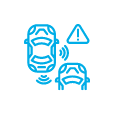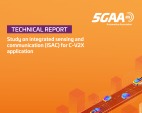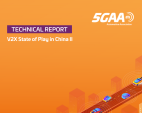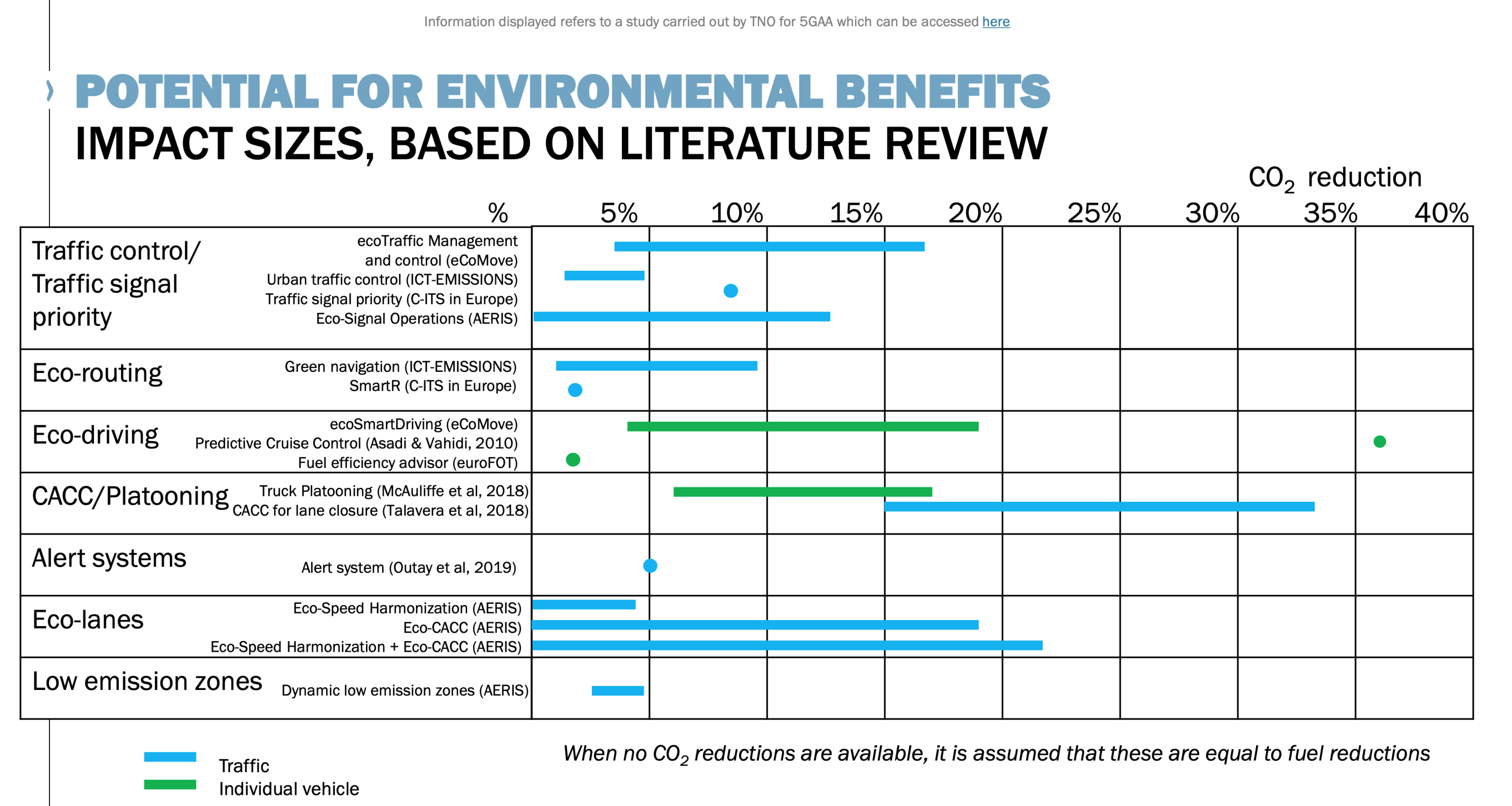
About us
Connected Mobility for People, Vehicles and Transport Infrastructure
The 5G Automotive Association (5GAA) is a global, cross-industry organisation of companies from the automotive, technology, and telecommunications industries (ICT), working together to develop end-to-end solutions for future mobility and transportation services. Created in September 2016, 5GAA has rapidly expanded to include key players with a global footprint in the automotive, technology and telecommunications industries. This includes automotive manufacturers, tier-1 suppliers, chipset/communication system providers, mobile operators and infrastructure vendors.

5GAA was created to connect the telecom industry and vehicle manufacturers to develop end-to-end solutions for future mobility and transportation services.
Mission
5GAA bridges the automotive and telecommunication industries in order to address society’s connected mobility needs, bringing inclusive access to smarter, safer and environmentally sustainable services and solutions, integrated into intelligent road transportation and traffic management.
A visionary roadmap
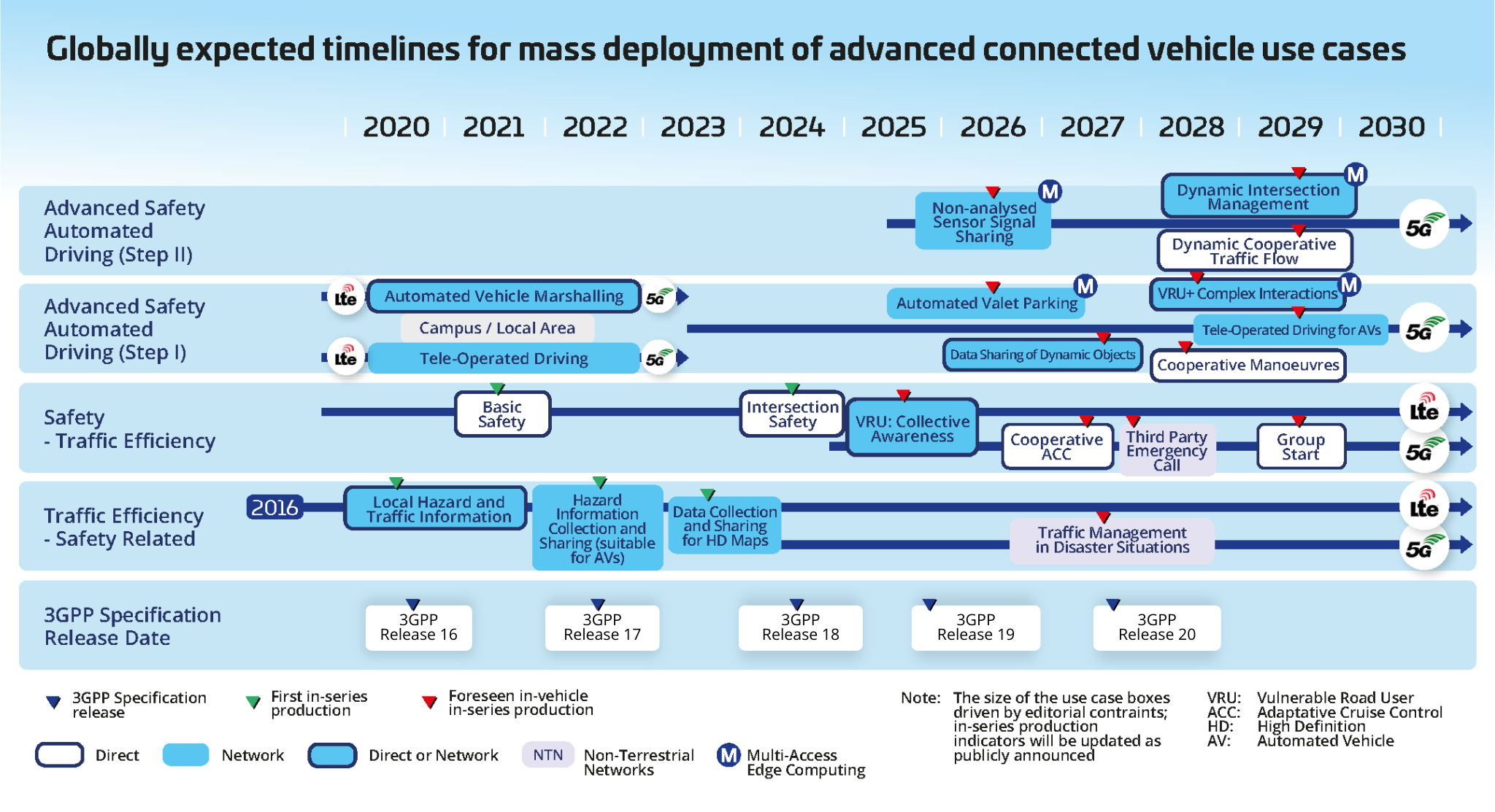
What we do
5GAA is addressing today’s mobility key challenges. With C-V2X technology, 5GAA will revolutionise the mobility ecosystem and the way drivers interact with the world. 5GAA’s ambition is to improve the overall transportation industry to make it safer, greener and more efficient for vehicles, road users and the surrounding infrastructure.

5GAA has defined 4 strategic pillars designing the short and long term goals in very diverse domains contributing to the same ambition: Connected Mobility.

Connected Mobility
Sustainability
Sustainability benefits of C-V2X
Cellular Vehicle-to-Everything, or C-V2X, communications will make transportation not only safer and smarter but also more sustainable.
Sustainability has three dimensions: environmental, social and economic.
C-V2X ticks all three boxes:
- Environmental: By helping to make every trip smarter, safer and more efficient, C-V2X helps reduce congestion and accidents, thereby reducing air pollution, noise pollution and energy use.
- Social: Saving lives and avoiding injuries are clear social benefits. By enabling real-time communication between pedestrians, cyclists, traffic infrastructure and moving vehicles, including motorcycles and electric scooters, C-V2X will help avoid accidents that otherwise would result in injuries and deaths.
- Economic: By enabling more efficient mobility, C-V2X will save people and employers billions of man-hours currently wasted in traffic jams. Those man-hours can then be dedicated to more rewarding activities.
C-V2X also enables the growth of autonomous mobility, which in turn offers even greater sustainability benefits, for example mobility-as-a-service offerings.
To learn more, watch the short video or scroll down for more details.
C-V2X and Sustainability in detail
ENVIRONMENTAL BENEFITS

- Transport still represents about 25% of Europe’s total CO2 emissions. By helping to make every trip smarter, safer and more efficient, C-V2X helpsreduce congestion and accidents, thereby reducing energy use, noise pollution and air pollution.
- C-V2X can help all vehicles operate and deliver people and goods more efficiently, thereby reducing pollution and optimizing the use of valuable energy resources.
- INRIX calculated that each second of reduced delays at traffic signals across the United States would translate to an annual reduction of 800,000 metric tons of CO2.
- Connected vehicle technology can help electric cars calculate an energy-optimised route to a charging station that’s not necessarily the fastest or nearest but requires the least energy to reach.
- Examples of environmental benefits enabled by C-V2X technologies include:
- Current technology permitting smarter routing for all vehicles in both urban and rural areas, for example via automated traffic routing, road, bridge, tunnel and parking availability updates and smart parking.
- Future technology permitting “green waves” for emergency vehicles, cars, trucks, lorries and other vehicles instead of stop-and-go traffic.
- Future technology facilitating manoeuvres and cooperation in traffic.
- For more detailed information, please see TNO’s report for 5GAA on the Environmental Benefits of C-V2X.
SOCIAL BENEFITS

- By enabling real-time communication between pedestrians, cyclists, traffic infrastructure and moving vehicles, including motorcycles, C-V2X will help avoid accidents that otherwise would result in injuries and deaths.
- According to the World Health Organisation, there were 1.35 million traffic deaths globally in 2016, the latest year for which global data are available. Road traffic deaths are a leading cause of death among young people, in particular.
- In the European Union, there were about 20,608 road deaths in 2023, or about 46 road deaths per million inhabitants.
- In the United States, an estimated 40,990 people died in road accidents in 2023. The United States Department of Transportation has set an ambitious goal of zero traffic deaths, in part by leveraging advanced technologies to prevent accidents in the first place.
- It says: “The U.S. Department of Transportation’s National Roadway Safety Strategy specifies that zero is the only acceptable number of deaths and serious injuries on our roadways. USDOT is committed to taking substantial, comprehensive action to achieve this goal.”
- By providing real-time hazard notifications and enabling connected cooperative driving, C-V2X makes transportation safer for all road users, including cyclists. As C-V2X makes the roads safer, more people may feel confident in choosing cycling as their primary mode of transportation.
- A U.S. DOT pilot study demonstrated that C-V2X technology can prevent accidents and injury for vulnerable road users.
- Green waves and corridors for emergency vehicles can help save lives and reduce injuries, allowing people to lead longer, healthier and more fulfilling lives.
- Response times are critical for emergency vehicles and first responders to save lives. A 2020 study showed that “green waves” at traffic lights could reduce response times by as much as 30% with little impact on overall traffic conditions.
- By enabling more efficient mobility, C-V2X will save commuters billions of man-hours currently wasted in stressful traffic jams.Those man-hours can be dedicated to more enjoyable and rewarding activities such as doing sports, hobbies, volunteering, education or spending time with friends and family.
- In Europe, the average driver in some cities loses more than 150 hours per year stuck in traffic jams.
- Americans lost as much as 3.4 billion hours in traffic in total in 2021.
- C-V2X helps connect other modes of transport with one another to facilitate a real multi-modal transportation system.
ECONOMIC BENEFITS

- By enabling automated driving and mobility as a service, C-V2X will help create new products and services that help drive more sustainable economic growth.
- For example, anonymous data collected through C-V2X can help governments and policymakers develop more effective infrastructure maintenance programmes and traffic plans.
- By enabling more efficient mobility, C-V2X will save employers and entrepreneurs billions of man-hours currently wasted in traffic jams.Those man-hours can then be dedicated to more rewarding activities.
- For commercial vehicles, C-V2X can help optimise delivery routes and schedules and reduce the number of empty or partially loaded trips. Efficient route management reduces energy use and pollution.
- The deployment of C-V2X technologies in vehicles can increase demand for 5G and future networks, each of which will be more energy-efficient than the technologies they replace.
Want to learn more?
If you want to learn more about the timeline for the introduction of next-generation C-V2X communications technologies, including those with clear environmental benefits, please see our latest C-V2X technology Roadmap here.
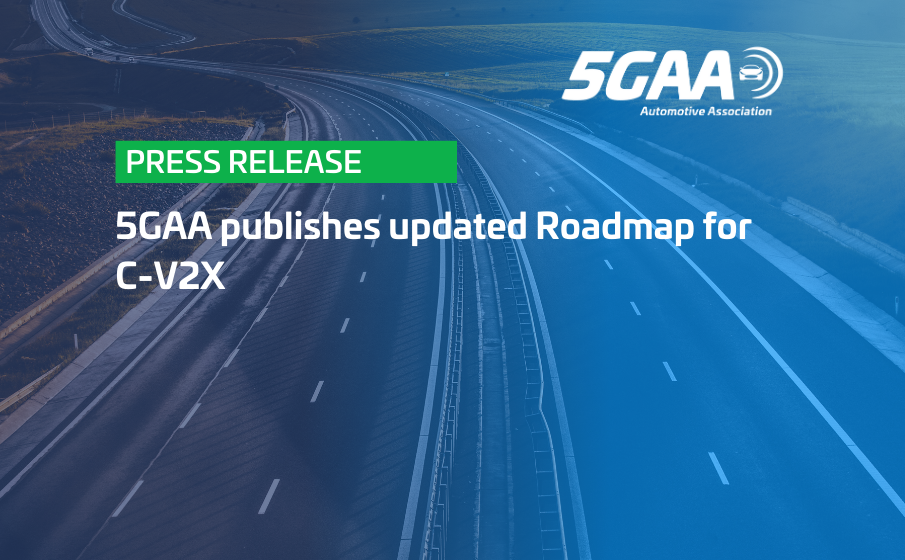
5GAA publishes updated Roadmap for C-V2X
BRUSSELS, 3 December 2024 – The 5G Automotive Association (5GAA) has sketched out an upbeat vision for better transportation safety, efficiency and sustainability with the third edition of its Roadmap for advanced driving use cases, connectivity, and technologies.
The 24-page Roadmap III builds upon a 5GAA white paper first published in 2020 and updated in 2022. It includes both a summary of market and technological developments since the last report as well as a forecast of the market readiness and roll-out of connected mobility technologies through 2030, with a focus on cellular-vehicle-to-everything (C-V2X) technology.
Thanks to the rapid expansion of cellular networks worldwide, about 300 million vehicles, including about two-thirds of all cars sold in the world’s major automotive markets, are now “connected.” Moreover, road and other infrastructure owners and operators have continued to expand a network of roadside sensors, traffic lights and other devices that help make transportation smarter, safer—including for pedestrians, cyclists and other vulnerable road users—and more sustainable.
While most vehicles and infrastructure to-date have relied on C-V2X technology to communicate with one another via cellular networks, the Roadmap also sees a growing role for “direct” vehicle-to-vehicle and related communications as soon as two years from now. 5GAA expects 5G-V2X Direct-enabled vehicles and related services to begin to be mass-deployed between 2026 and 2029, starting in Europe.
In addition, the third edition of the Roadmap for the first time describes a timeline for new use cases enabled by non-terrestrial networks and advanced Multi-Access Edge Computing (MEC). Satellite connectivity could help guarantee ubiquitous service in rural areas and disaster situations as soon as 2027, for example.
“Connected vehicle technologies and the market have both come a long way, since 2000,” said Maxime Flament, 5GAA Chief Technology Officer. “Our latest Roadmap foresees the continuous evolution of C-V2X cellular and direct communications technologies that will help save lives, make transportation more efficient and more sustainable and accelerate the spread of autonomous vehicles,” he said.
5GAA sees the Roadmap as a guide to help vehicle manufacturers, telecommunications network operators, road and other infrastructure owners and operators, as well as governments, understand the investments, speed and spectrum requirements needed to ensure the most efficient deployment of the new technologies and services. This, in turn, can help governments achieve their stated vision of zero road fatalities more quickly and also expedite the deployment of autonomous vehicles.
You can download the full Roadmap here.
About 5GAA
The 5G Automotive Association (5GAA) is a global, cross-industry organization of more than 115 members, including leading global automakers, Tier-1 suppliers, mobile operators, semiconductor companies, and test equipment vendors. 5GAA members work together to develop end-to-end solutions for future mobility and transport services. 5GAA is committed to helping define and develop the next generation of connected mobility, automated vehicles, and intelligent transport solutions based on C-V2X. For more information about 5GAA, please visit www.5GAA.org.
For further information please contact:
5GAA Marketing & Communications – Marcom@5GAA.org

Meet Our Members – Interview with Menno Malta, Monotch CEO
The 5G Automotive Association (5GAA) thrives on the collective expertise and collaborative spirit of its members. Over 110 organisations strong, our membership represents a global network of market leaders and innovators shaping the future of connected mobility.
We are kicking off a new series, “Meet Our Members,” to delve deeper into the stories of the individuals who make up the backbone of 5GAA. First up, we will be featuring Menno Malta, CEO of Monotch, who has been actively involved in one of 5GAA’s most recent and exciting areas of work – Vehicle-to-Network-to-Everything (V2N2X) communication.
This interview series will showcase a diverse range of profiles, highlighting their contributions, challenges, and predictions for the exciting world of 5G-connected transportation. Get ready to be inspired by the passion and ingenuity of our members as we meet the people who make 5GAA.
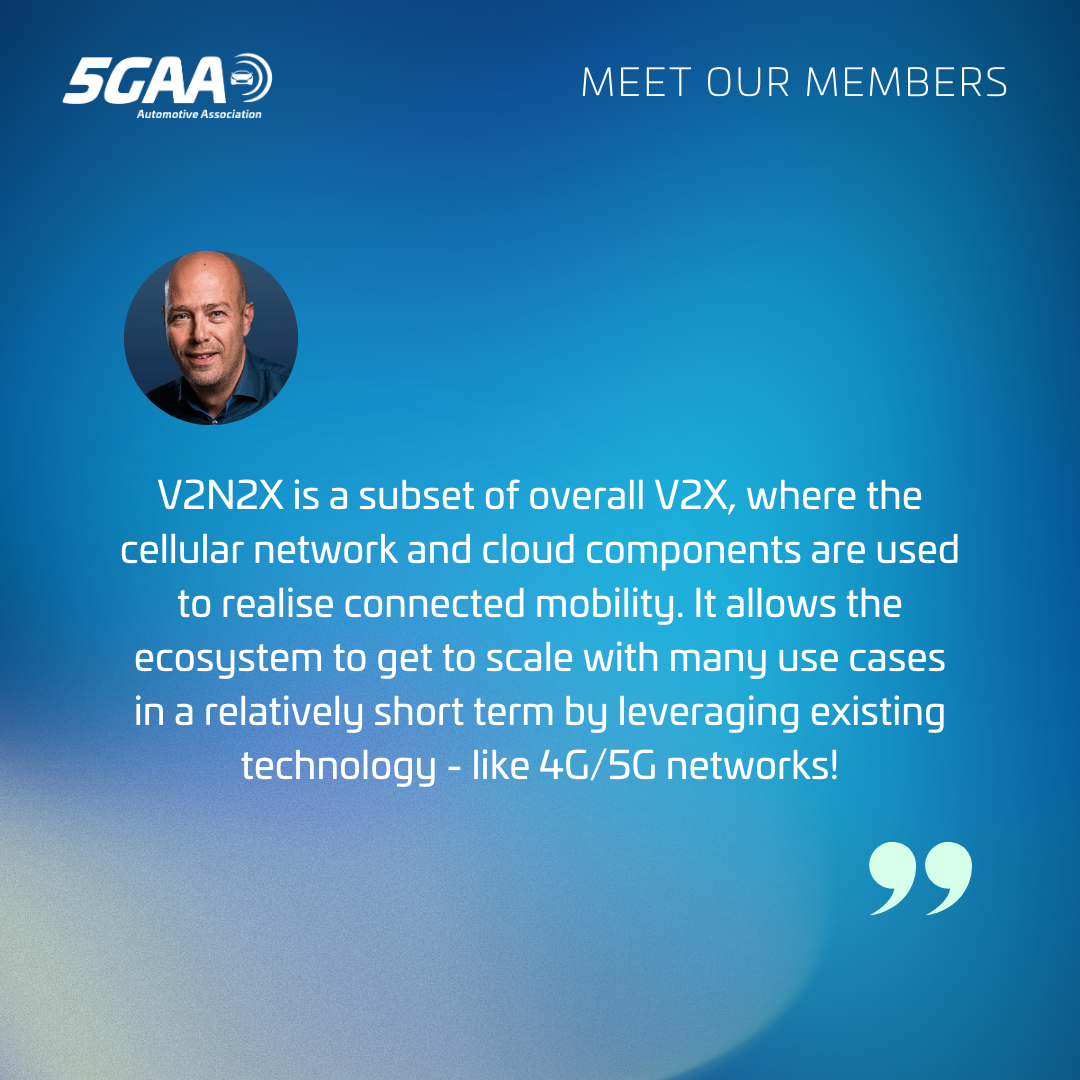
Menno, you are the CEO of Monotch, a 5GAA member company. How does Monotch’s work relate to 5GAA’s, and what keeps you engaged with our association?
Monotch operates at the forefront of the V2N2X market. Our proven TLEX platform is used by cities and road authorities all over the world to connect mobility and digital infrastructure bringing substantial societal benefits and increased cost-effectiveness.
The initial interest that drew us to 5GAA was the opportunity to engage with OEMs, mobile network operators, and related industries. This is still of interest! We really appreciate the possibilities to discuss developments and work jointly on progressing the market. The networking opportunities are also great for us.
Monotch is based in the Netherlands. Last year, your views were instrumental in the organisation of 5GAA’s workshop in the Hague, where we looked at C-V2X deployment in the Low Countries. Two years later, what is the state of play for C-V2X and connected mobility in the Netherlands, and how do you see it unfolding?
In the Netherlands, we see a steady growth of smart and connected roadside infrastructure as well as new use cases such as emergency vehicle warnings that are now available on a large scale. This leads to more connected parties, including the first vehicle OEMs. On top of this, there is a push on urban challenges and use cases, which will lead to even more data and impact in the next few years. The Netherlands is truly a lighthouse deployment, and authorities from other countries come here often to see what’s happening and how they can apply learnings in their own jurisdiction.
One of 5GAA’s recent areas of work has been vehicle-to-network-to-everything (V2N2X) communications, and you’ve been one of its main contributors. What is V2N2X, what makes this such an important topic, and what are some of the biggest hurdles to overcome in achieving its widespread adoption?
V2N2X is a subset of overall V2X, where the cellular network and cloud components are used to realise connected mobility. It allows the ecosystem to get to scale with many use cases in a relatively short term, as it leverages existing technology such as apps, onboard units and, of course, the 4G/5G network! I think it’s hugely important for 5GAA as it shows the value of a connected ecosystem to the main stakeholders and can kickstart overall C-V2X deployment.
The V2N2X work item has been concluded with the publication of a white paper, ‘Road Traffic Operation in a Digital Age,’ and two associated reports. What is the objective of these publications, and how do they complement each other?
The white paper can be seen as a summary of the Technical V2N2X Architecture report. It’s a great read for everyone involved in this market, whether you’re an authority or a private sector executive. The Technical V2N2X Architecture report offers detailed insights into the blueprint architecture, and I recommend it to subject matter experts.
The other technical report is of a different nature. It describes the V2N2X market from a business perspective—for example, the market size, the kinds of business models we see, and which factors drive the market. It also contains descriptions of large-scale example deployments, taking away whatever doubts people might have about the feasibility of V2N2X..
The upcoming online session on 18 June will present the findings of these publications. What are you most excited about sharing with the audience?
So much to share! I can promise the session will be packed with insights, but I’m probably most excited to share the OEM and IOO (Infrastructure Owner and Operator) customer profiles we created. It’s about their goals, pains and gains, and for this, we did a survey and an analysis of large-scale deployments. I’m so excited about it because it really ties to the why of our work.
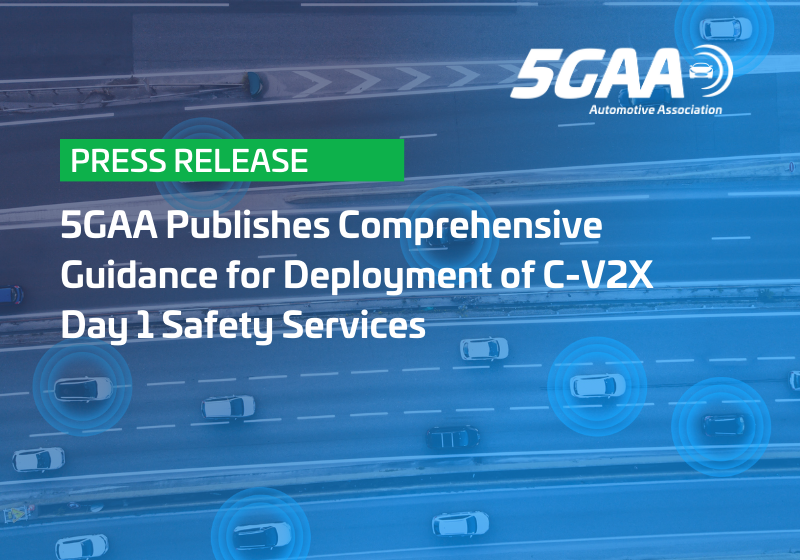
5GAA Publishes Comprehensive Guidance for Deployment of C-V2X Day 1 Safety Services
Detroit, October 23 – A coalition of industry leaders, including the 5G Automotive Association (5GAA) and Crash Avoidance Metrics Partners (CAMP LLC), has released a comprehensive guidance aimed at infrastructure owners and operators for the deployment of Vehicle-to-Everything (V2X) technology, specifically focused on C-V2X direct communication at 5.9 GHz in the United States (US).
The guidance, developed by 5GAA, benefitted from essential input from ITS ecosystem stakeholders and partners, including the Utah Department of Transportation, National Electrical Manufacturers Association (NEMA), OmniAir, the Intelligent Transportation Society of America (ITS America), and researchers from the University of Michigan.
The document is a valuable reference for “Day One” C-V2X deployment by gathering established requirements and new considerations, and it provides compatible guidance for several Day 1s, ranging from road infrastructure owner-operators seeking early deployment based on waivers, through Day 1 where automakers deploy. The primary target audience includes road Infrastructure Owners and Operators (IOOs), who are pivotal in taking up C-V2X technology for transportation safety and efficiency.
The 5GAA guidance report focuses on C-V2X direct communications and streamlines this complex field into commonly understood profiles, simplifying deployment timelines, and ensuring effective communication between vehicles and infrastructure.
It also provides findings from various guidelines, standards, and deployment projects to offer a straightforward guide for Vehicle-to-Vehicle (V2V) and Vehicle-to-Infrastructure (V2I) connectivity required for Day One Connected Vehicle (CV) applications. In addition, it includes guidance and a profile on the messages that can be sent.
The complementary nature of both modes of communication (C-V2X and V2N) can deliver a richer experience for end-to-end use cases by leveraging both local short-range and cloud-based long-range connectivity.
Key highlights of the report include:
- Clarifying expectations for a swift V2X roadside unit deployment, providing concise and accessible materials for all participants in safe traffic communications.
- Identifying a limited but crucial set of messages, interoperability needs, and performance requirements to expedite deployments, ensuring an orderly and safety-critical message set.
- Providing SAE J3161 communication profiles and parameters, creating a standard set of rules for optimal channel access and message usage.
The report aims to establish V2X communications that support interoperability and data integrity, delivering the necessary performance for various Day One applications. It also offers insights into potential Day Two messages, preparing the V2X community for the next deployment stage.
Find the complete report here.
About 5GAA
The 5G Automotive Association (5GAA) is a global, cross-industry organization of over 120 members, including leading global automakers, Tier-1 suppliers, mobile operators, semiconductor companies, and test equipment vendors. 5GAA members work together to develop end-to-end solutions for future mobility and transport services. 5GAA is committed to helping define and develop the next generation of connected mobility, automated vehicle, and intelligent transport solutions based on C-V2X. For more information, visit our website.
Media Contact
5GAA Communications Team: marcom@5gaa.org

5GAA live demos show C-V2X as a market reality
Turin, 14 November 2019 – Smart mobility technology is a reality today, with ‘Cellular Vehicle-to-Everything’ (C-V2X) allowing connected vehicles to communicate with the cloud, directly with each other and their surroundings. Deployment plans are primarily sustained by the global trend in the automotive industry to adopt 4G LTE cellular technology, followed by the emerging 5G high-speed low latency communications. Beyond infotainment, C-V2X will capitalize on vehicular and smartphone connectivity to contribute to better safety, less congestion and reduced emissions.
During a live demo event in Turin, the 5G Automotive Association (5GAA) showcased ready to deploy use cases in the streets of the city and a sneak preview of what the future has in store on the renowned Lingotto rooftop test track.
Prominent members and partners of the 5GAA including Audi, Continental, Ericsson, Fiat Chrysler Automobiles, Harman Samsung, Marelli, Pirelli, Qualcomm, TIM and Vodafone demonstrated the current state of C-V2X and the road to future, Vehicle-to-Vehicle (V2V), Vehicle-to-Infrastructure (V2I), and Vehicle-to-Network (V2N) applications based on 4G LTE and 5G.
“Connected mobility is a market reality.” says 5GAA Chief Technology Officer, Dr. Maxime Flament. “The use cases demonstrated in the streets of Turin are planned for deployment with a huge industry momentum based on the evolution path to 5G capabilities.”
Using both direct short-range communications and mobile networks, the open-road demonstrations showcased the extensive capabilities of today’s C-V2X technology, ready for deployment. To name a few:
- Protecting vulnerable road users, for instance, by alerting drivers about a pedestrian at a crossing using LTE-connected infrastructure.
- Smoothing traffic by allowing public authorities and road operators to provide real-time warnings to drivers in urban environments concerning roadworks or speed limits, via the network.
- Preventing incidents at dangerous intersections or in the event of unexpected braking, thanks to C-V2X direct-short range communications between vehicles.
The track demonstrations at Lingotto underlined the enhanced safety benefits that can be expected thanks to the versatility of 5G and the wide range of services it enables. To name a few:
- Vehicles will geo-tag dangerous areas for the following cars or provide ‘see-through’ functions to avoid dangerous overtaking.
- Pedestrians will be detected directly via their smartphones and surrounding vehicles will be warned.
- In case of accidents, emergency services will be able to visualize the situation live using on-board cameras of surrounding vehicles, improving response times and providing emergency responders situational awareness prior to arriving at the crash scene.
Furthermore, Intel showcased an “In Vehicle Entertainment” demo at the Museum, in collaboration with Marelli, TerraNet and Equinix, showing how Multi-Access Edge Computing (MEC) can support immersive high-definition (HD) entertainment for all occupants of a moving vehicle, including video streaming, gaming, virtual reality (VR), office work, online education, advertisement.
A short summary on each of the 5GAA C-V2X use cases, demonstrated today in Turin
Demo 1 “Vulnerable Road Users”: open road demos on safety
In this trial – which is part of Torino Smart Roads Initiative patronized by the Municipality of Turin – TIM, Links Foundation and Luxoft showed how the communication between the various actors moving along the roads can help in detecting potentially dangerous situations. The goal of the demos was to demonstrate how the 5G mobile network facilitates the protection of Vulnerable Road Users: pedestrians (“Presence of a pedestrian on a crosswalk”) and cyclists (“Presence of a connected bike on the road”). In the case of a pedestrian approaching a crosswalk, a Roadside Unit connected to the mobile network, equipped with a camera able to detect the event, sent a warning message to the nearby connected vehicles (I2V communication). In the case of a connected bike and a connected vehicle that are approaching each other, the two vehicles received a warning message about their presence when a risk of collision is detected.
Demo 2 “Urban Georeferenced Alerting” in open roads
TIM, FCA, Links Foundation, City of Turin with 5T, and Politecnico di Torino showed how the Local Traffic Authority in Turin intends to notify drivers in real time of possible dangers and special situations on the road (traffic jam, road works warning, dynamic speed limit, etc.). A standard geo-referenced warning message was dispatched to a TIM AMQP broker” at the edge of the 5G mobile network and only the involved vehicles received the geo-localized message from the AMQP Broker using the TIM 5G Network. The warning was read and displayed in an FCA vehicle through the on-board HMI and can for instance notify the driver of upcoming speed reduction. The aim of the trial was to demonstrate how the TIM 5G Network is suitable for realizing smart roads services for connected cars. The solution is compliant with the standards so it can be applied in other locations covered with mobile networks.
Demo 3 Intersection Movement Assist (IMA), Forward collision Warning (FCW)
FCA and Harman Samsung showcased two Vehicle to Vehicle (V2V) demos, by integrating C-V2X direct-short range communication into Maserati Levante and Quattroporte. The vehicles, through a direct radio link (network-less radio link), anonymously communicated basic information such as their position and related direction.
The Forward Collision Warning (FCW), detected possible frontal collision and warned the driver accordingly. The Intersection Movement Assist (IMA), assisted the driver at the cross junctions to avoid a possible lateral collision with an oncoming vehicle.
Demo 4 Emergency Electronic Brake Light (EEBL), Stationary Vehicle Warning (SVW)
FCA, Continental, and Qualcomm demonstrated fast and reliable information exchange between vehicles in emergency situations. The two demos are based on C-V2X direct-short range technology, enabling Vehicle-to-Vehicle (V2V) communication between two Jeep Renegade. There were two portions to this demo:
- “Stationary Vehicle Warning” (SVW): when the hazard lights are activated, the application broadcasted a message to all nearby vehicles so that approaching vehicles could be informed even if the hazard was not visible.
- “Emergency Electronic Brake Light warning” (EEBL): in the event of a sudden braking, the application broadcasted a message to following vehicles, such that approaching vehicles were notified of the potentially dangerous situation.
Demo 5 See-through
Vodafone, FCA, Vodafone Automotive, Marelli and Altran revealed the ‘See Through’ that uses C-V2X long-range cellular network communication to exchange streamed video in real time between vehicles, extending the driver’s visual range under obstructed visibility scenarios and to prevent accidents, especially those that may occur in an overtaking phase. The two involved Jeep Renegades vehicles were equipped with a connectivity solution (Marelli) and high frame-rate cameras (Marelli Motorsport) to detect the road lanes.
A real time tracking system and a space mapping algorithm of the vehicles, specifically developed by Vodafone Automotive, allowed Vodafone’s Multi-access Edge Computing (MEC) to dynamically manage and route the video flows on the basis of the vehicles’ relative positions and to ensure minimal end-to-end latency in the interest of drivers’ safety. Vodafone 5G ultra-low latency and high reliability were paramount to ensure the flow and synchrony of the real-time video exchange between vehicles, also under high traffic and cell saturation conditions.
Demo 6 World-first 5G-enhanced ADAS services
Audi, Ericsson, Italdesign, KTH, Pirelli, Qualcomm, TIM and Tobii showed how smart cars, commercial 5G smartphones and 5G networks jointly improve comfort, safety and efficiency. This unique collaboration combined the power of eye-tracking glasses, intelligent tires, in-vehicle augmented reality and 5G phones to work together over a live 5G network. With its high capacity and low latency, cellular 5G connectivity is ready to enable instantaneous cooperation between vehicles, the IoT ecosystem and more advanced driver assistance services. The live demonstrations at the Turin Lingotto test track were based on TIM’s commercial 5G network delivered in Turin in partnership with Ericsson. Audi cars, equipped with Pirelli Cyber Tyre, and embedded 5G modems provided by Qualcomm and available 5G smartphones were utilized to enhance pedestrian’s safety.
About 5GAA
The 5G Automotive Association (5GAA) is a global, cross-industry organisation of over 130 members comprised of leading global automakers, Tier-1 suppliers, mobile operators, semiconductor companies and test equipment vendors. It works together to develop end-to-end solutions for future mobility and transport services. 5GAA is committed to helping define and develop the next generation of connected mobility, automated vehicle and intelligent transport solutions based on C-V2X.
Learn more on the 5GAA website and follow us on Twitter and LinkedIn.
Media Contacts
5GAA Marketing & Communications
Email: marcom@5gaa.org
Official pictures: Conference – Demonstrations

5GAA Meets Toronto 2019: Face-to-Face Meeting and Workshop
Toronto is hosting the next quarterly 5G Automotive Association (5GAA) Face-to-Face meeting. The event spans over five days focused on cellular-to-everything (C-V2X) technology.
The first three days will be dedicated to meetings on Working and Cross-Working Group Items. Days four and five will kick off with board and executive level discussions and a workshop on connected and automated driving in North America. These exciting events will be coupled with live demonstrations, hosted by 5GAA Canada-based members.
The 5GAA Workshop
5GAA will be hosting a workshop around ‘C-V2X: The Future of Connected and Automated Driving in North America’. With over 200 attendees expected, the event targets North American transport stakeholders, including policymakers, road traffic authorities, road operators and an array of interest groups and industry representatives. The primary objective is to raise awareness of C-V2X and the opportunity it provides to drive its adoption in North America.
The workshop will be divided in two parts, the first part will focus on an update to C-V2X development, including an overview of the European Road Map, as well as examples of recent innovation in Europe and North America. The second part will embark on a broader path, concentrating on future connected mobility. Key figures from Intelligent Transportation Systems (ITS) in North America will be presenting and take part in the day’s discussions. See workshop programme here.
Due to limited capacity, the workshop is by invitation only. Please contact liaison@5gaa.org for more information.
Live Demonstrations
5GAA members, Bell Canada and Huawei Canada, will organise two separate demonstrations of C-V2X 5G technology, 6-8 August 2019.
One demonstration, HD Mapping and Vulnerable Road User (VRU) Vehicle to Network, will take approximately 30 minutes and feature an in-vehicle live HD Map/VRU system.
The other demonstration will centre on Tele-operated Driving (ToD) Vehicle to Network technology. It will last approximately three hours at the Bell campus in Mississauga, Canada. There will be lunch served and a shuttle service to and from the Metro Toronto Convention Centre. Delegates can register here.
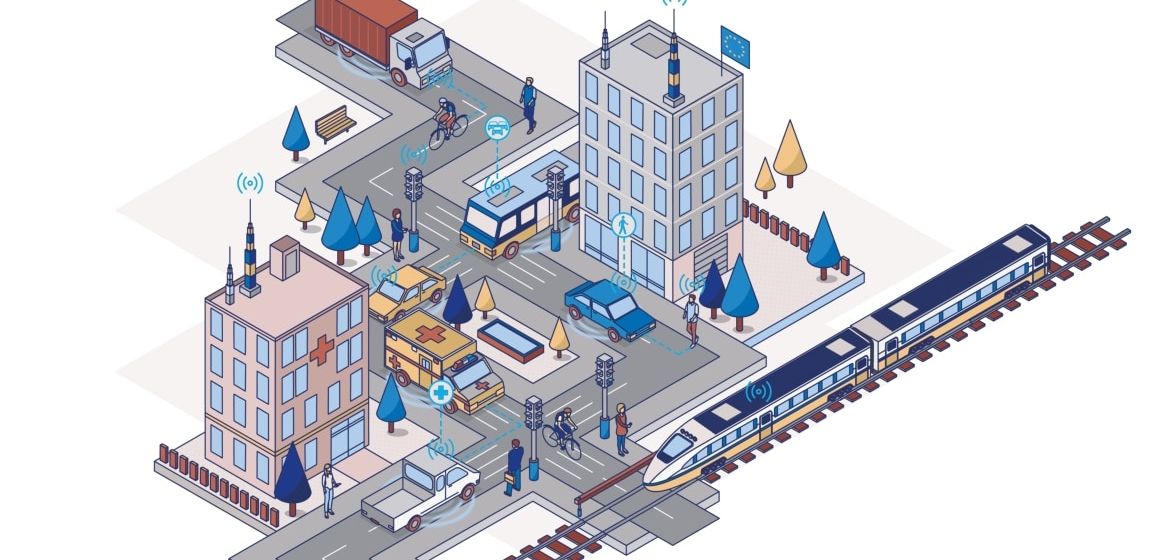
Europe’s leadership in connected and automated driving depends on technology-neutral, innovation-oriented policies
Dear Minister,
Serious concern has arisen in the telecoms and transport industries over the restrictive content of the forthcoming Delegated Act on Cooperative Intelligent Transport Systems (C-ITS). Although it is close to completion, the text still does not lay down the technology-neutral framework urged by the CEOs of 24 members of our associations (signatories included BMW, Daimler, Deutsche Telekom, Ericsson, Ford, Groupe PSA, Nokia, Telefonica and Vodafone) in their letter to President Juncker in July 2018[1].
Despite a welcome acknowledgement of cellular technologies, the draft Delegated Act only contemplates the Cellular Vehicle-to-Everything (C-V2X) technology family in the framework of a future revision of the Act in up to three years’ time, with no guarantee to date that a level playing field will be ensured with respect to compatibility and interoperability requirements.
The current draft effectively endorses Wi-Fi based communication (known as “ITS-G5”) as the baseline technology for connected cars in the EU, at the expense of a mature and standardised alternative[1]: LTE-V2X (which is the current realisation of C-V2X). We believe this contradicts the principle of technology neutrality and will prove to be a very costly missed opportunity for Europe.
Indeed, LTE-V2X is regarded internationally as the foundation stone which will pave the way towards the most advanced safety services enabled by 5G, in particular for vulnerable road users. Only C-V2X offers such a clear evolutionary roadmap starting with LTE-V2X today and evolving into 5G-V2X tomorrow, making it the only future-proof technology.
A decision exclusively favouring Wi-Fi technology today should thus be carefully considered. It would bear negative long-term consequences for Europe, since Wi-Fi offers no prospect of compatibility with 5G. A costly migration path would be required, resulting in significant sunk costs. It would stall C-V2X roll-out and investments in 5G for automotive and alongside the road network would be adversely affected.
LTE-V2X must be allowed to succeed as the first building block en route to the full realisation of 5G potential, ensuring the competitiveness of key industry verticals such as automotive as well as the telecom sector. A wrong decision at this critical juncture would put in jeopardy Europe’s leadership and investment in 5G.
Connected vehicle and roadside infrastructure technology is evolving at a very fast pace. LTE-V2X field tests and deployment projects are under way in many EU countries as well as globally with the first market introductions foreseen in 2019, within the same timeframe as the Delegated Act publication.
Leveraging all the previous work from European standardisation organisations, C-V2X offers unique benefits as a single technology platform, combining both direct short-range (not requiring network coverage or a subscription) and long-range modes.
It will, unhindered, significantly improve road safety in Europe through direct vehicle-to-vehicle, vehicle-to-infrastructure and, vehicle-to-network communication, but also provide new vehicle-to-pedestrian applications owing to its unique smartphone integration capacity, thereby reducing vulnerable road users’ casualties (43% of EU road fatalities in 2017)[1].
C-V2X also provides the fastest way to reach large-scale penetration of C-ITS: all new vehicles are expected to feature embedded cellular connectivity by 2021-2022. Many OEMs have already deployed some Day 1 C-ITS services using existing 3G/4G networks and LTE-V2X long-range mode.
We strongly believe that Europe should capitalise on these early deployments and would gain substantial economic benefits by maximising the synergies between transport and telecom network infrastructures. Today, LTE network population coverage averages 97.9% in Europe (89.9% of rural EU households) with a rapid year-on-year increase[2], whereas ITS-G5 deployment has not yet begun.
In addition, consumer 5G is rapidly moving from trials to early commercialisation. Between 2018 and 2020, 48 countries will launch 5G mobile services across North America, Europe, the Middle East and Asia-Pacific.[3]
This is not about promoting individual companies that are about to launch their respective products. It is about creating the right framework which will support Europe to make the best technology choices in the future, to achieve our common objective: making the roads safer for all.
We encourage you to support a truly technology neutral approach to C-ITS through a Delegated Act inclusive of LTE-V2X, as it holds the promise of better safety. C-V2X is close to deployment in every world region as our entire ecosystem has stepped up its efforts to be market-ready in the upcoming months. However, it is absolutely critical for our industries that the EU regulatory framework provides sufficient legal certainty in order to pursue and accelerate current roll-out plans for C-V2X.
Afke Schaart Johannes Springer Lise Fuhr
VP and Head of Europe, Director General, 5GAA Director General, ETNO
Russia and CIS, GSMA
[1] CEO Letter to President Juncker on connected car legislation
[2] Cf. Annex to this document
[3] Road Safety in the EU – Trends, statistics and main challenges
[4] Broadband Coverage in Europe 2017, European Commission
[5] GSMA intelligence
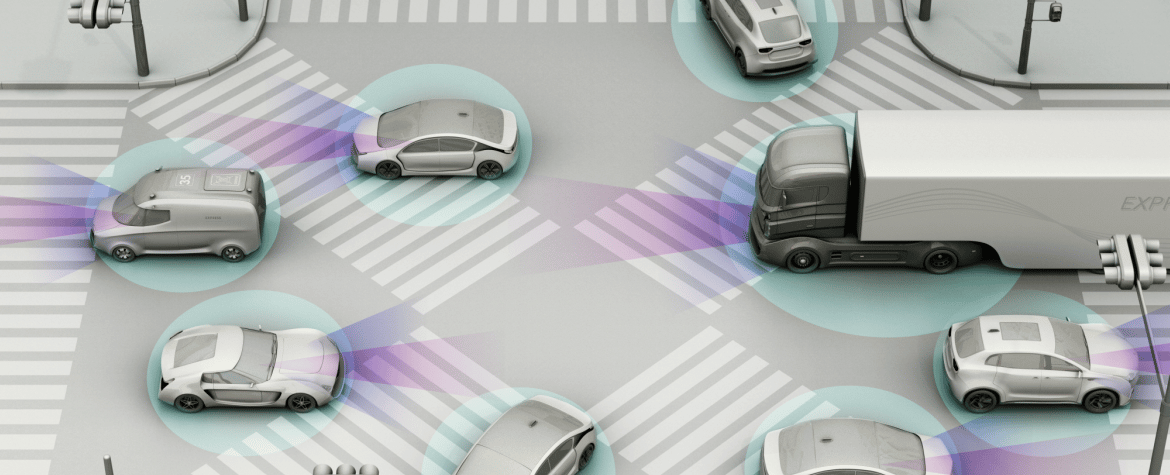
5GAA: cellular technology is key enabler for smart mobility of the future
Industry association calls on European Commission to allow stakeholders to work collaboratively towards an agreement on the technology catalyzing the mobility of the future and warns against a “premature and cumbersome legislative decision”.
The 5G Automotive Association (5GAA) encourages the automotive, technology, and telecommunications industries and the European Commission to be ambitious when evaluating technologies for connected, autonomous vehicles. 5GAA is confident that cellular communication technology (C-V2X) has the most benefits when applied to connected, self-driving cars. It has provided its views to the Commission in a workshop and a letter with recommendations. Since its launch one year ago, over 50 industry leaders from the automotive, technology and telecommunications industries have teamed up in 5GAA to accelerate C-V2X technology development and its evolution to 5G-V2X for enhanced safety, automated driving and connected mobility.
Christoph Voigt, Chairman of 5GAA said, “5GAA is confident that cellular technology (including direct vehicle-to-vehicle communication at 5.9 GHz) has the potential to lead to the best outcomes in the long run. We are strongly relying on the European institutional support to put in place a regulatory framework allowing for an industry-driven and swift deployment of this technology. It is crucial to consider how the 5.9 GHz band, the “life blood” of wireless vehicle communication, can be used efficiently in the context of 5G technology evolution, road safety, and economic scalability. The automotive and transportation sectors, both public and private, are making significant investment commitments. Therefore, we are urging the European Commission to allow the ITS-G5 and C-V2X stakeholders to work together towards an agreement on the future of connected and automated cars, without a premature and cumbersome legislative decision.”
5GAA has recently provided its views to the Commission in a workshop and a letter with recommendations.
Christoph Voigt: “We should aim high enough when selecting the solutions to make connected, self-driving vehicles a reality. These are a catalyst to improving the quality of life globally through safer traffic, improved mobility, cleaner air in cities, and a better experience overall for drivers.”
Dino Flore, Director General of 5GAA adds, “Saving lives through improved road safety is obviously the primary positive outcome of deploying communication technology solutions. In addition, we should take into account other aspects when evaluating alternatives. We’re not only talking about reducing congestion and pollution but also optimizing the driving experience. It is our view that cellular technology, including direct vehicle-to-vehicle communication at 5.9 GHz, has the most upward potential in the long run.”
Helping vehicles “understand the environment they are navigating”
Launched in September 2016 by 8 founding members the 5GAA has in less than a year grown to include over 50 leaders from the automotive, technology and telecom industries who collaborate cross-industry on the future of transport. 5GAA’s mission is to develop, test, and promote communications solutions, initiate their standardization and accelerate their commercial availability and global market penetration. The objective is to address society’s connected mobility and road safety needs with applications such as autonomous driving, ubiquitous access to services and integration into smart city and intelligent transportation.
Connected vehicles use communication technology to not only communicate with other vehicles but also with road infrastructure, other road users such as pedestrians, and the Internet – e.g. to provide traffic updates and parking guidance. Use cases include collision warnings, “traffic jam ahead” warnings, green light optimal speed advisory, parking guidance, and assisting drivers in tackling treacherous traffic situations (e.g. turning left at a crossroads). Connected vehicles will eventually reduce pollution, and make traffic more efficient, reducing congestion in cities and improving the flow of goods and people.
Christoph Voigt explains, “Equipping cars with sensors and cameras is one thing, but imagine what is possible when cars use cellular technology to communicate with their entire ecosystem: other vehicles, road users, infrastructure, and central services that give real-time information.”
“It’s the difference between a car that is capable of seeing what is happening in its immediate surroundings and one that can use all available information to allow for a safer and more comfortable driving experience. After all, as drivers we do more than purely react to what’s in front of us. We listen to traffic info, we are aware of the area we’re navigating, and we are alert to traffic jams in rush hour. We use context to guide our driving.”
“This is exactly what cellular connectivity can enable vehicles to make easier, or even take over from us in the case of self-driving vehicles. Except that it will be faster and more accurate,” concludes Christoph Voigt.
-Ends
About 5GAA
The 5G Automotive Association (5GAA) is a global cross-industry organisation of companies from the automotive, technology and telecommunications industries (ICT), working together to develop end-to-end solutions for future mobility and transportation services. Created in 2016, the Association is comprised of over 50 members which mission
is to develop, test and promote communications solutions, initiate their standardization and accelerate their commercial availability and global market penetration to address societal need. For more information please visit 5gaa.org
Contacts
Robbe Libbrecht
FINN PR
robbe.libbrecht@finnpr.com
M +32 497 23 30 38
5GAA Marketing & Communications
marcom@5GAA.org




